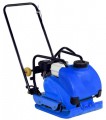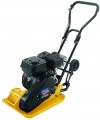Impact force
The force of each impact provided by the vibrating plate during operation. The intensity of the impact directly depends on this indicator, and, consequently, the density and thickness of the material that the vibrating plate can effectively compact. At the same time, in some cases (for example, when working with paving slabs), a high impact force may be undesirable. Recommendations on the optimal value of this indicator for different cases can be found in special sources.
Vibration frequency
The frequency of movements made by the sole of the tool in normal operation. For different materials, the optimal vibration frequency may also be different; specific recommendations can be found in special sources. It should be noted that classical vibrating plates (see "Type") have a rather high frequency of operation — from 3700 beats / min and above, but in vibrating rammers this figure is much lower and rarely exceeds 700 beats / min; such differences are due to differences in the way they work.
Speed
The speed of the vibrating plate in normal operation. This parameter, along with the size of the sole, determines the performance of the unit. High speed allows you to quickly cope with a vast amount of work, however, it requires the appropriate engine power, which affects the "gluttony" and the price of the vibrating plate.
Power
Vibratory plate motor power in horsepower. Horsepower is traditionally used to denote the power of internal combustion engines (see "Engine"); 1 HP approximately equal to 735 watts.
Higher power, other things being equal, makes the tool easier to work with and reduces the effort required to control it. On the other hand, this indicator significantly affects the cost and consumption of electricity or fuel (depending on the type of engine, see above). Also note that the vibrating plate motor must be powerful enough to, firstly, move it forward, and secondly, provide the desired vibration frequency and not allow it to “burrow” into the material being processed. At the same time, in inexpensive models, the cost is sometimes reduced precisely through the use of low-power engines. Therefore, if the power seems too small for such a weight, it is better to clarify this ratio (there are special tables for this) and, if necessary, refrain from buying.
Power
Vibratory plate motor power in kilowatts. Watt (kilowatt) is the universal unit of power; unlike horsepower, this designation is used for all types of engines.
Higher power, other things being equal, makes the tool easier to work with and reduces the effort required to control it. On the other hand, this indicator significantly affects the cost and consumption of electricity or fuel (depending on the type of engine, see above). Also note that the vibrating plate motor must be powerful enough to, firstly, move it forward, and secondly, provide the desired vibration frequency and not allow it to “burrow” into the material being processed. At the same time, in inexpensive models, the cost is sometimes reduced precisely through the use of low-power engines. Therefore, if the power seems too small for such a weight, it is better to clarify this ratio (there are special tables for this) and, if necessary, refrain from buying.
Fuel tank volume
Nominal volume of the fuel tank of a vibrating plate with an internal combustion engine (see “Engine type”), in other words, the amount of fuel that the unit can carry with it. Knowing this indicator, as well as fuel consumption (see below), you can determine the time of continuous operation on a single refill — by dividing the tank capacity by the consumption. At the same time, we note that it is usually more convenient to regularly refuel a relatively small tank than to carry a large (and, accordingly, heavy) supply of fuel with you. With this calculation, manufacturers choose the volume of the fuel tank — so that the vibrating plate does not have to be refilled too often and at the same time so that the fuel tank does not greatly affect the dimensions and weight.
Crankcase oil capacity
The volume of oil that must be in the engine crankcase for the normal operation of the vibrating plate.
The crankcase is the outer casing of the engine, which plays, among other things, the role of a lubricant reservoir in four-stroke internal combustion engines (see "Type of internal combustion engine"). If the oil level is too low, it will not be able to flow normally to the rubbing parts, which is fraught with engine overheating and the corresponding consequences. This parameter allows you to estimate how much lubricant is needed for the initial refueling or complete oil change.
Water sprinkler system
The presence
of an irrigation system in the design of the vibrating plate.
Some types of work (in particular, with asphalt and bituminous mixtures) require constant wetting of the sole of the vibrating plate so that the rammed material does not stick to it. For such cases, irrigation systems are provided, consisting of a water tank and a system for supplying it to the sole.
Noise level
The level of noise generated by the vibrating plate during operation.
This parameter is quite approximate, because. the actual "loudness" of the operation may vary depending on the material under the sole and other factors. At the same time, it fully allows you to evaluate the features of the unit: the lower the noise level, the more comfortable it will be to work with a vibrating plate.
The decibel is a non-linear unit, so the actual noise figures are easiest to evaluate using special comparative tables. Detailed correspondence tables can be found in special sources. Here we note that vibrating plates are quite noisy equipment, among them indicators below 85 dB are extremely rare (this is comparable to a loud scream). And the most "loud" models give out about 105 – 108 dB — this volume corresponds to an industrial workshop with heavy equipment or a music centre at full volume; at these noise levels, hearing protection is highly desirable.

